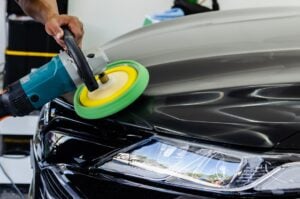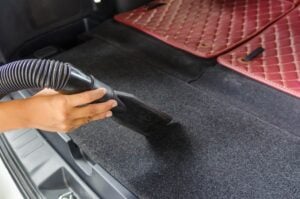Table of Contents
ToggleUnderstanding Brake Dust Damage: Causes and Effective Prevention Tips
You take pride in the appearance of your car. However, even after a fresh wash, those stubborn black specks continue to appear on your wheels and lower panels. That’s brake dust. If you ignore it, it won’t just dull your wheels. It can corrode finishes, stain paint, and even hurt braking performance over time. But the good news is you don’t have to live with it.
Brake dust damage is not only an aesthetic concern; it can lead to significant long-term effects on your vehicle.
Let’s walk through exactly what’s happening to your wheels, why it matters, and how NJ wheel treatments can help you keep your vehicle looking sharp, day after day.
What is Brake Dust?
Regular maintenance is essential to prevent brake dust damage.
Understanding brake dust damage starts with knowing how it affects your wheels.
- Brake dust is a fine, sticky powder that forms when the brakes are applied. Each time you step on the brake pedal, the pads press against the rotors.
That friction is what slows your car down. But it also grinds away tiny particles of:
- Iron and steel from the rotors.
- Carbon and metallic fibers from the pads.
- Adhesive resins that hold everything together.
These particles heat up and get a static charge, so they cling to your wheels like a magnet. This is why, even if you just washed your wheels, a short drive can coat them in a dull gray or black film.
Why Brake Dust is Worse Than You Think?
-
- Many drivers assume brake dust is just cosmetic. But it’s corrosive and damaging. If you leave brake dust sitting on your wheels, it can:
Left untreated, brake dust damage can cause severe issues with your vehicle’s performance.
Etch into the Clear Coat
- The gritty metal particles start to bite into the protective clear coat. Over time, this causes pitting, scratches, and discoloration.
Cause Rust and Corrosion
- Moisture reacts with the metallic dust, creating a breeding ground for rust. Especially in NJ’s wet winters, this corrosion can spread quickly.
Reduce Resale Value
-
- Nothing says “neglected car” like wheels stained brown or black from baked-on brake dust.
Brake dust damage affects your car’s resale value significantly.
Interfere with Braking Performance
- Excessive dust can accumulate on rotors and calipers, leading to uneven wear, vibration, or squealing brakes.
If you’ve ever tried scrubbing brake dust off and noticed it doesn’t budge, that’s because it’s already bonded to the surface.
Why Do Some Vehicles Have More Brake Dust?
Identifying the reasons for excessive brake dust damage can help in selecting the right pads.
- Not all brake pads are created equal. Some materials naturally produce more dust. Let’s break it down:
Semi-Metallic Pads
- Most common, affordable, and effective, but they produce the most dust.
Organic Pads
- Made of rubber, glass, or resin. Softer and quieter, but still dusty.
Ceramic Pads
- Made from ceramic fibers. Produce very little dust and last longer, but at a higher cost.
If you have performance brakes or high-torque vehicles (SUVs, trucks, sports cars), you’ll likely see more brake dust.
Understanding the type of brake pads can help mitigate brake dust damage.
How to Remove Brake Dust Correctly?
- Before you can prevent brake dust, you need to get rid of what’s already there. Follow these proven steps:
1. Always Start with Cool Wheels
- Brake dust bakes onto hot surfaces. Make sure your wheels are completely cool to the touch before cleaning.
2. Pre-Rinse Thoroughly
- Use a hose or pressure washer to remove loose grit and grime. This helps prevent scratching while you scrub.
3. Choose the Right Cleaner
Avoid harsh acids or degreasers that can damage finishes. Look for:
- pH-balanced wheel cleaners
- Formulas designed to dissolve iron particles
- Products that are safe for clear-coated, painted, or powder-coated wheels
4. Agitate Gently
- Use a soft-bristle wheel brush to get between spokes
- A wheel mitt for larger flat surfaces
- A detailing brush for lug nuts and crevices
- Don’t use kitchen scrub pads, they’ll ruin your finish.
5. Let the Cleaner Dwell
- Give the product 1–2 minutes to break down the dust. You’ll often see it turn purple or red as it reacts with iron particles.
6. Rinse Completely
- Spray until all suds and grime are gone. Be thorough. Leftover cleaner can stain.
7. Dry Immediately
- Use a microfiber towel to prevent water spots.
Preventing Brake Dust: 5 Smart Strategies
- Cleaning helps, but prevention is the real secret. Here’s how you can dramatically reduce brake dust build-up:
1. Apply a Ceramic Wheel Coating
This is the most effective solution in Morris County. Ceramic coatings:
This ceramic coating protects against brake dust damage, enhancing your car’s appearance.
- Create a glass-like shield over the wheels.
- Repel brake dust, road grime, and moisture.
- Last up to 2 years with proper maintenance.
While they cost more up front, you’ll spend less time cleaning and avoid expensive repairs later.
2. Use a Dedicated Brake Dust Repellent
A dedicated brake dust repellent can significantly reduce brake dust damage.
- These sprays form a temporary barrier.
- Easy to apply after each wash.
- Typically protects for 2–4 weeks.
- Ideal if you don’t want to commit to ceramic coating.
3. Install Brake Dust Shields
-
- These metal plates fit behind your wheels to catch falling dust.
Brake dust shields can help shield your wheels from brake dust damage.
- Affordable and simple to install.
- Reduce dust deposits by up to 80%.
However, they can sometimes reduce cooling and aren’t recommended for heavy towing or racing.
4. Upgrade to Ceramic Brake Pads
Upgrading can greatly reduce brake dust damage.
If you’re tired of constant dust, switching to ceramic pads is a smart move. Benefits include:
- Much less dust.
- Quieter operation.
- Longer lifespan.
Be aware that they cost more and may not be suited for all vehicles.
5. Wash More Frequently
Don’t wait for dust to bake onto the wheels. In NJ, aim for:
Regular washes help prevent brake dust damage.
- Weekly washes in summer.
- Every 2–3 weeks in winter, to remove salt and brake dust.
Why Professional NJ Wheel Treatments Are Worth It?
You can do all this yourself. However, it’s a time-consuming and messy process. Here’s why many NJ drivers prefer a professional detailer to handle wheel protection:
Thorough Decontamination
Shops use powerful but safe chemicals and tools to remove every speck of embedded dust.
Expert Application:
- Ceramic coatings require meticulous prep and precise curing. DIY kits often fail because the surface isn’t clean enough.
Long-Term Savings
Preventing corrosion now means you won’t pay for wheel refinishing or replacements later.
Addressing brake dust damage early can save you money.
Peace of Mind
You drive knowing your wheels are protected in any weather. If you’re serious about keeping your wheels pristine, professional wheel treatment is an investment in your vehicle’s longevity.
What Happens If You Ignore Brake Dust?
You might think it’s harmless to let brake dust sit, but here’s what happens over time:
2 weeks: Dust becomes harder to remove.
1–2 months: Corrosion begins under the clear coat.
Ignoring brake dust damage can result in costly repairs down the road.
6 months: Pitting and staining are visible.
1 year: Protective finish deteriorates, and wheels may require refinishing.
Don’t wait for damage you can’t reverse.
How to Choose the Right Wheel Service in NJ?
Not all wheel treatments are created equal. Look for:
-
- Certified detailers with ceramic coating training.
Ensure your chosen service effectively addresses brake dust damage.
- Positive reviews and proven results.
- Clear pricing without hidden fees.
- Options for maintenance packages.
When you invest in your vehicle, choose a shop that treats it like its own.
Final Checklist to Keep Brake Dust at Bay

Monitoring your wheels will help prevent brake dust damage.
Here’s your go-to action plan:
- Wash wheels weekly with pH-balanced cleaner.
- Dry thoroughly to avoid spotting.
- Apply brake dust repellent monthly.
- Consider using ceramic pads to reduce dust in the long term.
- Protect with a professional ceramic wheel coating.
- Inspect brakes regularly to avoid mechanical issues.
Follow these steps, and you’ll enjoy clean, protected wheels all year long.
Your Next Step
If you’re ready to stop brake dust damage before it starts, consider scheduling a professional NJ wheel treatment. Want to make sure every detail of your car looks its best? Learn how Cab Detailing NJ Services can protect and revive every inch of your ride. Explore our professional detailing solutions here.
Preventing brake dust damage now ensures your car remains in top condition.



